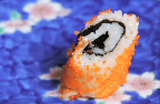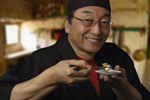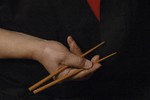Thanks to Yoshio for once again inspiring me to push my ideas about cooking..and yes, Yoshio…you are truly the master in any style of cuisine! Your corned beef and cabbage was perfect! Thank you to Showa for having me, and special thanks for the young women of Yoshio’s class that were so cordial listening to my talk about Irish-American and Irish cuisine. I really enjoyed meeting you all and your help with the setup and breakdown of the meal was especially gracious! I had such a fun day!
Here the recipes (and the influences) we made for you:
Corned Beef and Cabbage (Irish-American, a variation of New England Boiled Dinner)
- 4 lb “Corned” Brisket of Beef (“corned” is Anglo-Saxon for “salted”)
- 6 Large Carrots-peeled, ends taken off
- 3 Small Parsnips-peeled
- 3 Large Turnips-peeled and halved
- 1 Head of Cabbage-cored and quartered
- 6 Medium-sized Potatoes-peeled (Yoshio had a variety of types)
- Spices/Flavors: 1 heaping Tablespoon of each: Whole Pepper, Juniper Berries, Cloves and Corse Salt. A few sprigs of fresh Parsley-chopped
What you want to do is get each of the harder veggies (carrots, parsnips, turnips and potatoes) in about 2-3″ chunks. Yoshio cooked this dish in a pressure cooker. If you’ve never used a pressure cooker before, please, PLEASE get someone who knows, to show you!!!! You can get same results with a steady boil & simmer in an open pot, but this takes about two hours! Either way, please consult “The Joy of Cooking (JOC)”, p.412 for cooking all the ingredients, in their proper order for both pressure cooker and open pot.
Colcannon (Irish: “cál ceannann” a truly Irish dish. Essentially, mashed potatoes, onions and/or leeks and kale or cabbage.)
- 2 Lbs. Potatoes, peeled and cubed
- 1 Lb. Kale (best) or Cabbage (OK), washed, cored. chopped well
- 2 Leeks OR 1 Leek+1 Medium Onion, peeled washed really well (see below); chopped well.
- Spices/Flavors: Salt & Pepper, 1/4 Lb Butter, 1/4C Milk
I love leeks, but they can be the most dirty of the onion family. It takes a couple of washings, but they are worth it. First chop off the “beard” end (roots) and the green top (save for soup broth…yumm!) and wash stalk well in H2O. Chop well and wash the pieces in a colander and dry by putting colander in bowl for 10 minutes. When leek and kale are dry (I use a salad spinner) fry in wok with a little oil or butter until leeks are wilted…almost brown. Put aside. Boil cubed potatoes until soft. Remove from H2O and dry potatoes in a pan in 300°F oven for 10 minutes. Add to a bowl with S&P, butter and ,milk, mash, then beat until whipped. Fold in kale/leek. Put in buttered pan and bake @ 350°F oven until top is browned.
“Quick” Soda Bread (Irish: “arán sóide” a traditonal Irish and Irish-American dish.) I was pleased how this came out. I followed JOC p. 575 verbatim. Why fool with success?! Remember to cut a cross to “let the fairies out” and find someone else (like me!) to drink the rest of the buttermilk!
“Codling” Cream (also: “Coddling” Cream; f/ 1600’s; Irish w/British influence)
- 8 medium peeled, cored, sliced green apples
- 1+1/4C Wine (recipe called for white, I used port for that pink color)
- 1+1/4C H2O
- 3 Tblsp. Sugar (I used brown sugar)
- 1 Pint Heavy Cream
- 2 Egg Yolks
- 1 Tblp. Rose H2O (optional, if you can find it)
Again, while working cutting the apples, I keep them in H2O to keep from browning. Heat H2O and Wine with apples until they are soft. Strain and discard liquids. Add sugar to apples, mash and cool. Whip cream until stiff. Whip egg yolks separately until foamy, fold into whipped cream. Fold egg/cream into cooled apples. Add rose H2O last. Keep cold.




































